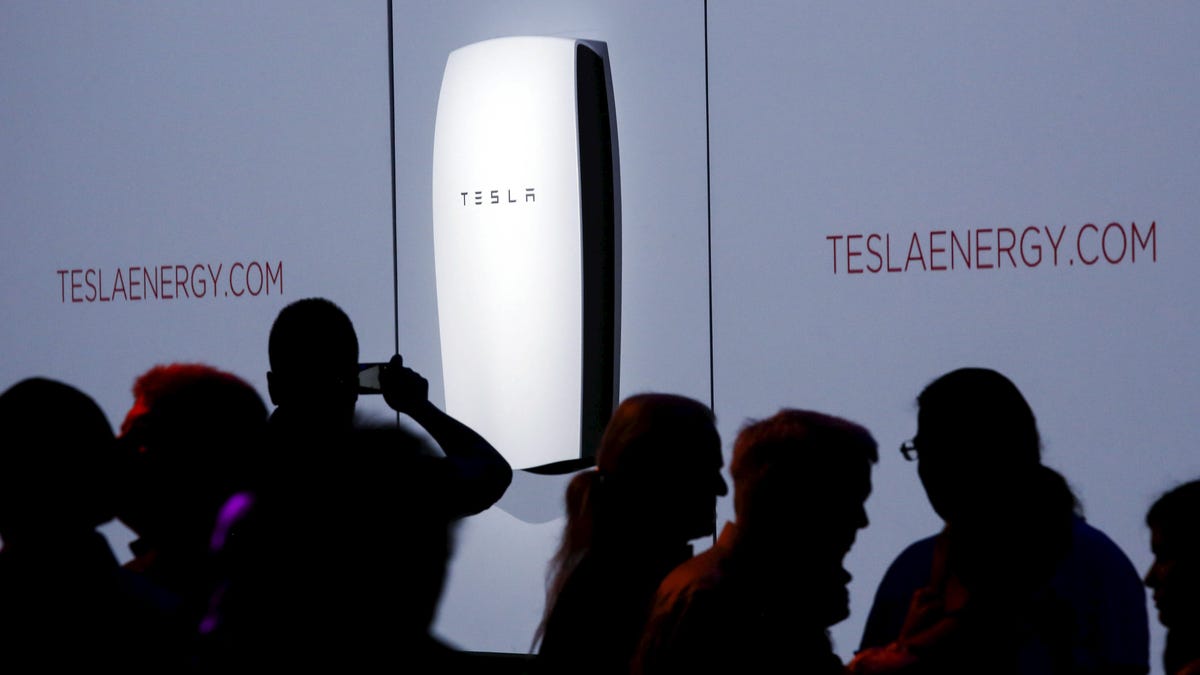
Attendees take pictures of the Tesla Energy Powerwall Home Battery during an event at Tesla Motors in Hawthorne, California April 30, 2015. (REUTERS/Patrick T. Fallon)
Tesla launched its home battery system in a blaze of publicity last month, attempting to change U.S. power usage. But what about the actual nuts and bolts of installing the Powerwall system?
That’s where solar power provider SolarCity comes in. The San Mateo, Calif.-based company, which has Tesla CEO Elon Musk as its chairman, will handle Powerwall installation.
Powerwall is a rechargeable lithium-ion battery designed to store energy at a residential level “for load shifting, backup power and self-consumption of solar power generation,” according to Tesla. It consists of Tesla’s lithium-ion battery pack, liquid thermal control system and software that receives dispatch commands from a solar inverter.
“We’re taking orders now for the 10 kWh Powerwall, and we expect to begin offering the 7 kWh option in the coming months,” Jonathan Bass, vice president of communication at SolarCity, told FoxNews.com, in an email.
“SolarCity’s management system will enable the Powerwall to be configured for a broad range of uses, including battery backup, time-of-use shifting and grid response, and we expect to support any or all of those functions in the future,” Bass said.
So, what are the installation options and the cost for Powerwall? One option is for the customer to prepay a nine-year battery backup service agreement for $5,000, Bass said. The lease includes installation, warranty, the Powerwall, the hybrid solar/battery inverter (which converts direct current electricity from solar panels or a home battery into the alternating current used by your home’s lights, appliances and devices) and the controls systems. Or a customer can purchase the same equipment and installation outright for $7,140, he said.
The 10 kWh Powerwall provides sufficient power to continue operating the most commonly needed circuits, including the refrigerator, lighting, computer, alarm system and electrical outlets. And two Powerwalls installed together could support the majority of household loads, including heating and cooling, according to Bass.
“Our average solar system produces more than 20 kWh per day, and the average American home uses approximately 30 kWh per day on average,” Bass said.
For residential solar systems needing backup, SolarCity will provide a turnkey battery backup service that includes permitting, installation and ongoing monitoring. “When the battery is depleted, it can be recharged by solar power even if the outage continues for multiple days,” according to Bass.
“There is tremendous interest in the product," he said. After the service launched, SolarCity achieved record sales leads the next day.
The solar (non-Powerwall) part of the installation is separate as spelled out by SolarCity here:
For remote communities, SolarCity will use the new Tesla battery in its GridLogic microgrid service that targets locations vulnerable to power outages and high energy costs, including remote or island communities, hospitals and military bases.
For businesses and government organizations, SolarCity will tap the Tesla battery for its DemandLogic energy storage system. DemandLogic – slated for use by “several” large retail, biotech and Internet companies in the U.S. – reduces energy costs by using stored electricity to reduce peak demand and can provide backup power during grid outages.




















